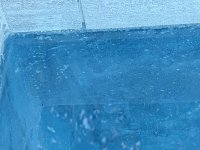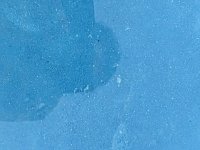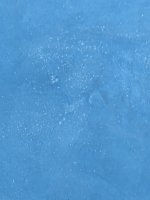I have a new pool, built in Nov 2022. In the spring we noticed some white spots in the plaster (NPT plasterscapes deep blue harbor). As the year progressed the spotting went from white to a grey discoloration. The discoloration is most prevelant on the stairs, ledge and deep end seat. The plaster company came out and did an acid bath (4 times) on one section determined to prove it was calcium. It wasn't and they just ended up scratching the heck out of the plaster with sand paper. They then decided it must by cyanuric acid staining due to poor water chemistry and told us we're SOL. I can prove through regular third party water tests not just my weekly testing that our water has always been balanced and our CYA has never been high. They are still determined to blame CYA staining and water chemistry despite zero evidence to support that and an abundance to dispute it. This back and forth has been going on for a while and in the meantime I found other customers with similar complaints who are being told the same thing despite professional pool service and documentation stating otherwise. This seems to be a pattern. I believe the issue is actually white spotting. The only way they will honor the warranty is if I can prove it's white spotting with plaster testing. At this point I'm ready to move forward with testing, but I don't know where to start to find a company to do the testing. Can anyone here recommend a company or direct me to where I would find such a company? I'm in Northern CA if that helps. Thanks
Plaster testing company needed
- Thread starter cindyflynn
- Start date
You are using an out of date browser. It may not display this or other websites correctly.
You should upgrade or use an alternative browser.
You should upgrade or use an alternative browser.
- Jul 21, 2013
- 53,931
- Pool Size
- 35000
- Surface
- Plaster
- Chlorine
- Salt Water Generator
- SWG Type
- Pentair Intellichlor IC-60
Before I suggest a cement lab to analyze your plaster, and while I am sure that high CYA levels would not cause white spotting, I prefer to know some things about your pool.
Is your plaster a quartz finish or an exposed pebble finish?
Please post a couple of photos of some white spots and post your current water readings, pH, alkalinity, calcium hardness, and CYA level.
Is your plaster a quartz finish or an exposed pebble finish?
Please post a couple of photos of some white spots and post your current water readings, pH, alkalinity, calcium hardness, and CYA level.
We have a plaster pool, standard plaster not pebble. NPT Plasterscapes in color deep blue harbor.Before I suggest a cement lab to analyze your plaster, and while I am sure that high CYA levels would not cause white spotting, I prefer to know some things about your pool.
Is your plaster a quartz finish or an exposed pebble finish?
Please post a couple of photos of some white spots and post your current water readings, pH, alkalinity, calcium hardness, and CYA level.
I should have started taking pics when I first noticed the spots, but I was told to expect some variation in color due to the dark color. These are from August when our pool 9 mos old. It went from some lighter color variation to really bad in just a few months. Today is testing day so I attached a screenshot of my test results.
Background I have a third party test our water to double check my results at least 1-2x per month. I'm a newbie so I like to have confirmation that I'm testing correctly. I test weekly with a Taylor kit. I have printed records showing that our water is balanced except for minor pH and chlorine adjustments from the third party. Our startup and first 30 days was done by builders start up company.
The pic with my finger is after the plaster company did the acid bath and sanded trying to fix the issue. That was the result of sanding.
Attachments
-
 PXL_20230930_180450394.jpg446.2 KB · Views: 26
PXL_20230930_180450394.jpg446.2 KB · Views: 26 -
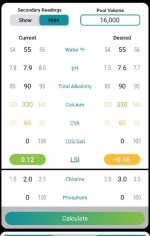 IMG_20231116_150732~2.jpg36.7 KB · Views: 23
IMG_20231116_150732~2.jpg36.7 KB · Views: 23 -
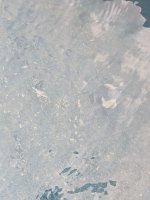 PXL_20230930_180521072.jpg296.6 KB · Views: 24
PXL_20230930_180521072.jpg296.6 KB · Views: 24 -
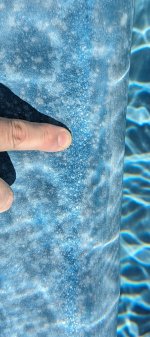 PXL_20231011_200209702.jpg427.7 KB · Views: 26
PXL_20231011_200209702.jpg427.7 KB · Views: 26 -
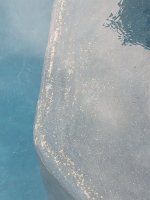 PXL_20230930_180535530.jpg355.9 KB · Views: 27
PXL_20230930_180535530.jpg355.9 KB · Views: 27 -
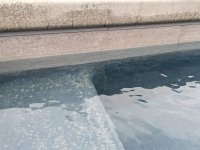 PXL_20230930_185300187.jpg546.4 KB · Views: 25
PXL_20230930_185300187.jpg546.4 KB · Views: 25 -
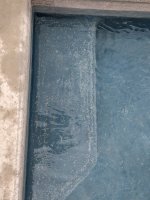 PXL_20230930_180438131.jpg588.9 KB · Views: 25
PXL_20230930_180438131.jpg588.9 KB · Views: 25
@onBalance I wanted to take some new pics of areas away from our ledge and steps because these areas look more like what the ledge and steps looked like 5ish months after plastering. We have no wind today so the water is like glass and good for pics. These are bottom of the pool, sides, the water line, etc. These are from all over the pool deep and shallow end.Before I suggest a cement lab to analyze your plaster, and while I am sure that high CYA levels would not cause white spotting, I prefer to know some things about your pool.
Is your plaster a quartz finish or an exposed pebble finish?
Please post a couple of photos of some white spots and post your current water readings, pH, alkalinity, calcium hardness, and CYA level.
Attachments
Yes, this appears to be the "white soft spotting" defect. The speed at which this whitening discoloration developed is surprising.
The first test that needs to be performed is for the calcium chloride content of the plaster. In order to do that, you must be willing to get a small chunk of plaster (one cubic inch) from the pool. Are you willing to do that? The cost of doing that analysis is $100.
Here are two articles that you may have seen.
 www.troublefreepool.com
www.troublefreepool.com
 www.troublefreepool.com
www.troublefreepool.com
 www.troublefreepool.com
www.troublefreepool.com
The first test that needs to be performed is for the calcium chloride content of the plaster. In order to do that, you must be willing to get a small chunk of plaster (one cubic inch) from the pool. Are you willing to do that? The cost of doing that analysis is $100.
Here are two articles that you may have seen.
White Spotting of New Plaster Pools
The problem of plaster spotting has been an ongoing puzzle and controversy in the swimming pool industry for over three decades. The generally round, smooth-yet-unsightly white soft spots in new plaster pools have long been a source of contention among pool plasterers, and pool chemical service...
Why Colored Plaster Turns White
Plaster colors can fade or turn whitish for a handful of preventable reasons. First off, scale can be deposited onto pigmented plaster surfaces by out-of-balance pool water. As is widely known, calcium scale makes the surface rough and turns it white, and acid washing is often the remedy...
High CYA Levels Do Not Stain Plaster
Contrary to some misinformation that has lately been floating around in the pool industry, high cyanuric acid (stabilizer) levels do not cause gray discoloration, or white spotting (“spot etching” as some incorrectly call it) in plaster swimming pools, no matter what. And there are several...
@onBalance yes we're willing to do whatever is needed. Plaster company won't honor the warranty unless we prove the issue is with the plaster. Our pool builder has been amazing and is going to cover the costs for the testing that needs to be done although I'd pay for it myself if that wasn't the case. I asked the owner of the plaster company how much calcium chloride they use and he says a .5% was used.
Have you contacted NPT?
If yes, what do they say?
If no, you should include them in the resolution of the problem.
If yes, what do they say?
If no, you should include them in the resolution of the problem.
I have tried repeatedly via email and phone with no response. The only contact info I can find is the number and contact form on their website. I would love to get a local rep out to look at our pool. I'm willing to jump through any hoop to get this resolved.Have you contacted NPT?
If yes, what do they say?
If no, you should include them in the resolution of the problem.
I would love to get a local rep out to look at our pool.

NPTpool Contact Us, NPTPool Toll Free Number | NPTpool.com
NPTpool Contact Us, Toll free number will help you to, Get help for all pool tile & pool finishes, Hardscapes & outdoor living tiles. Visit NPTpool.com
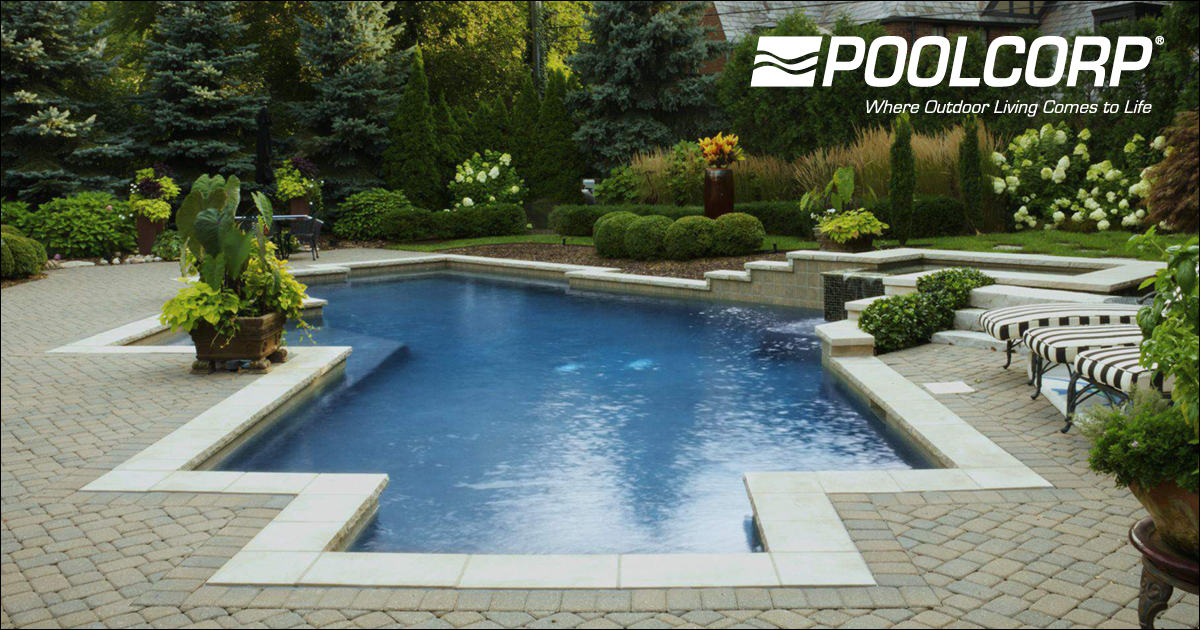
POOLCORP Worldwide Sales Centers | Pool Distributor | POOLCORP
Find our Sales Center & Distributors near your place. POOLCORP is a world's largest wholesale distributor of swimming pool supplies and pool equipment.

Pool Customers | POOLCORP Wholesale Pool Distributor
Become a POOLCORP customer and get access to more than 200,000 products. We offer our independent retail, service and builder partners. Learn more about our services

Consumer Resources | Npt Backyard | SwimmingPool | POOLCORP.com
Design your perfect backyard using the NPT Backyard App, explore the latest pool design, tile and finish trends and discover the best hot tub for you using our outdoor living resources. For more pool design inspiration ideas, Visit POOLCORP.COM
Thank you!

NPTpool Contact Us, NPTPool Toll Free Number | NPTpool.com
NPTpool Contact Us, Toll free number will help you to, Get help for all pool tile & pool finishes, Hardscapes & outdoor living tiles. Visit NPTpool.comwww.nptpool.com

POOLCORP Worldwide Sales Centers | Pool Distributor | POOLCORP
Find our Sales Center & Distributors near your place. POOLCORP is a world's largest wholesale distributor of swimming pool supplies and pool equipment.www.poolcorp.com

Pool Customers | POOLCORP Wholesale Pool Distributor
Become a POOLCORP customer and get access to more than 200,000 products. We offer our independent retail, service and builder partners. Learn more about our serviceswww.poolcorp.com

Consumer Resources | Npt Backyard | SwimmingPool | POOLCORP.com
Design your perfect backyard using the NPT Backyard App, explore the latest pool design, tile and finish trends and discover the best hot tub for you using our outdoor living resources. For more pool design inspiration ideas, Visit POOLCORP.COMwww.poolcorp.com
Are the spots softer than the normal area
the white surface feels no different to the touch than the colored part. It's all equally smooth and seems to be the same hardness when I touch it. If I were to close my eyes and feel the surface I cannot tell if I'm touching the white areas or color areas.Are the spots softer than the normal areas?
Get the testing done.
Maybe try a scratch test where you scratch over the spot and the regular plaster to see if the spots are softer and the scratch goes deeper.
Maybe try a scratch test where you scratch over the spot and the regular plaster to see if the spots are softer and the scratch goes deeper.
Perhaps I should clarify and explain the meaning of the term “soft spots” and why I use it when describing this plaster defect. Of course, another good term to describe this spotting defect is "porous and weak."
Years ago, onBalance submitted many samples of pool plaster that had developed white spotting to professional cement petrographers for their analysis of that pool plaster problem. Both Dr. Boyd Clark and Laura Powers and who are highly respected in their field of expertise, referred to this white spotting of pool plaster as being somewhat “soft” in comparison to normal quality made cement products.
It needs to be understood that quality made pool plaster will generally have at minimum a 3,000 PSI compressive strength and up to 5,000 PSI. When these white spots are examined using optical microscopy and scanning electron microscopy, the spots are excessively porous. And any cement area that is excessively porous will naturally be much weaker than surrounding areas that are much more dense and harder. Hence, that is why those two petrographers began using that term (soft) when describing the highly porous spots.
Even if the white porous spots have a compressive strength of only 1000 PSI, no one is going to be tell any difference of hardness by touching those spots with their fingers, or perhaps even by trying to scratch with a metal object. Even the cement and concrete industry use the term “soft” with poorly made concrete and that deteriorates.
The fact is those white porous spots do continue to decay and deteriorate over time simply because those spots are highly porous and weak. And since those spots would have a lower PSI, those spots ARE “softer” (but still relatively hard) than the surrounding unaffected plaster that is not porous and has not turned whitish.
Years ago, onBalance submitted many samples of pool plaster that had developed white spotting to professional cement petrographers for their analysis of that pool plaster problem. Both Dr. Boyd Clark and Laura Powers and who are highly respected in their field of expertise, referred to this white spotting of pool plaster as being somewhat “soft” in comparison to normal quality made cement products.
It needs to be understood that quality made pool plaster will generally have at minimum a 3,000 PSI compressive strength and up to 5,000 PSI. When these white spots are examined using optical microscopy and scanning electron microscopy, the spots are excessively porous. And any cement area that is excessively porous will naturally be much weaker than surrounding areas that are much more dense and harder. Hence, that is why those two petrographers began using that term (soft) when describing the highly porous spots.
Even if the white porous spots have a compressive strength of only 1000 PSI, no one is going to be tell any difference of hardness by touching those spots with their fingers, or perhaps even by trying to scratch with a metal object. Even the cement and concrete industry use the term “soft” with poorly made concrete and that deteriorates.
The fact is those white porous spots do continue to decay and deteriorate over time simply because those spots are highly porous and weak. And since those spots would have a lower PSI, those spots ARE “softer” (but still relatively hard) than the surrounding unaffected plaster that is not porous and has not turned whitish.
Last edited:
Cindy, I am glad you asked the plaster contractor about the content of calcium chloride. It would be great if you could get him to put that in writing (email, text, or letter).
I'm not sure that NPT is going to be willing to help out, but it is worth a try.
I also think you should try put him on the defensive and asked what plaster study has ever shown that high CYA levels causes white spots. He has a burden to prove his claim and is not just made up (which is the case).
Contrary to his claim, there is a study conducted by the National Plasterers Council that showed that a high level of CYA did not cause white spots or any other discoloration. We can use that to challenge him.
I'm not sure that NPT is going to be willing to help out, but it is worth a try.
I also think you should try put him on the defensive and asked what plaster study has ever shown that high CYA levels causes white spots. He has a burden to prove his claim and is not just made up (which is the case).
Contrary to his claim, there is a study conducted by the National Plasterers Council that showed that a high level of CYA did not cause white spots or any other discoloration. We can use that to challenge him.
Cindy, if you are interested, I can provide you with some literature and studies that will support your position. If NPT happens to agree to come out, it may help persuade them to support your position and go against the plastering contractor. It includes case studies on white spotted plaster, literature from the Portland Cement Association and American Concrete Institute that also acknowledges and documents that poor mixing, poor materials and additives, and poor troweling can cause spotting and other discolorations.
Even if NPT won't come out, this information can be used in court to support your claim. There is NO study that will supports the plastering contractor's claim that CYA causes white spotting or even bad water chemistry.
I don't there will be a need to do a full plaster analysis which costs around $3,000. We just need to check the chloride content and see if it is above 1% for us to go forward.
I am wondering why you haven't responded or posted since yesterday morning?
If you have any questions, let me know.
Even if NPT won't come out, this information can be used in court to support your claim. There is NO study that will supports the plastering contractor's claim that CYA causes white spotting or even bad water chemistry.
I don't there will be a need to do a full plaster analysis which costs around $3,000. We just need to check the chloride content and see if it is above 1% for us to go forward.
I am wondering why you haven't responded or posted since yesterday morning?
If you have any questions, let me know.
Thank you so much for this additional info. For some reason I stopped getting notifications of new replies so I hadn't checked back.Cindy, if you are interested, I can provide you with some literature and studies that will support your position. If NPT happens to agree to come out, it may help persuade them to support your position and go against the plastering contractor. It includes case studies on white spotted plaster, literature from the Portland Cement Association and American Concrete Institute that also acknowledges and documents that poor mixing, poor materials and additives, and poor troweling can cause spotting and other discolorations.
Even if NPT won't come out, this information can be used in court to support your claim. There is NO study that will supports the plastering contractor's claim that CYA causes white spotting or even bad water chemistry.
I don't there will be a need to do a full plaster analysis which costs around $3,000. We just need to check the chloride content and see if it is above 1% for us to go forward.
I am wondering why you haven't responded or posted since yesterday morning?
If you have any questions, let me know.
Our pool builder let the plasterer know that he was going to pay for any tests and is with us
I'm supposed to get an update next week so we'll see how things progress.
Thread Status
Hello , This thread has been inactive for over 60 days. New postings here are unlikely to be seen or responded to by other members. For better visibility, consider Starting A New Thread.




